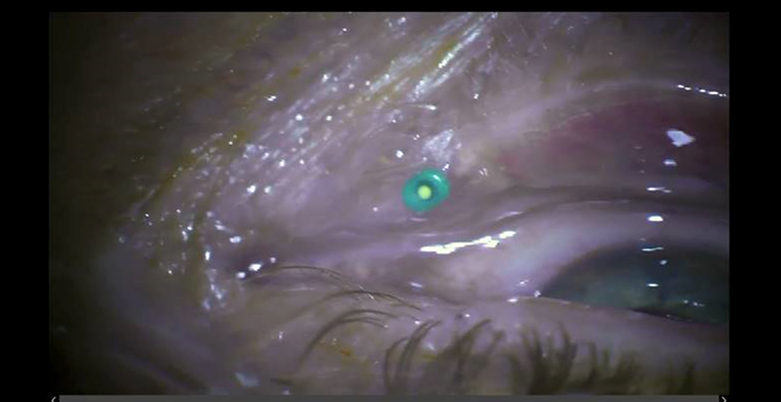Article
Novel delivery system shows positive performance in phase II trial
Author(s):

The nepafenac punctal plug drug delivery system (PPDS) was found to be safe and effective for reducing pain and inflammation associated with cataract surgery in a phase II FDA study.
A novel punctal plug drug delivery system (PPDS) was found to be safe and effective for reducing pain and inflammation associated with cataract surgery in a phase II FDA study.
Compared with placebo-treated controls, patients receiving the nepafenac PPDS also experienced fewer adverse events and superior visual acuity outcomes, said Eric D. Donnenfeld, MD.
“Inflammation is common following cataract surgery, and it can lead to serious complications if left untreated. Results of the ESCRS prospective PREMED study showed that NSAIDs were more important than corticosteroids for reducing the risk of CME,” said Dr. Donnenfeld, founder, Ophthalmic Consultants of Long Island, Garden City, NY, and clinical professor of ophthalmology, New York University, New York.
“The nepafenac PPDS simplifies medical management for the elderly patient population and resolves the problems associated with the use of topical medication,” he said. “It demonstrated unprecedented efficacy in reducing pain and inflammation after cataract surgery in the phase II study. If the outcomes are confirmed in phase III trials, the nepafenac PPDS may effectively replace topical NSAID drops in cataract surgery.”
Overcoming topical treatment challenges
Current treatment with topical medications suffers from many limitations. Efficacy depends on medication bioavailability and being used as directed. Conventional topical medications do not maintain a steady therapeutic concentration level of medication at the target site and patient compliance can be poor.
Some patients may not even fill their prescription because of the medication’s cost and some may have trouble instilling ophthalmic medications. Difficulty with the use of ophthalmic drops can be a particular problem in the cataract surgery population as older individuals are more likely to have arthritis or neurological conditions affecting their manual dexterity, Dr. Donnenfeld said.
Safety is also an issue with topical drops because they contain preservatives that can cause or exacerbate ocular surface disease, which is common in older individuals.
The nepafenac PPDS, which is being developed by Mati Therapeutics using its proprietary punctal plug platform (Evolute) for sustained drug delivery, can address the above issues. Made of non-biodegradable medical grade silicone, the L-shaped plug is well-tolerated and preservative-free. It is placed and removed by the ophthalmologist as an in-office procedure and delivers a consistent level of medication for one month of sustained efficacy.
“The PPDS is easy to insert and take out, and once inserted, it is cosmetically invisible. The PPDS has demonstrated excellent retention, but its presence in the punctum is also easy to confirm with eversion of the lower lid,” said Dr. Donnenfeld, who was principal investigator of the phase II nepafenac PPDS study.
Clinical trial design and results
The phase II clinical trial was a double-masked study that randomized patients undergoing cataract surgery 2:1 to receive the nepafenac PPDS or a matching plug holding placebo. The plug was inserted in the lower punctum of the scheduled surgical eye one or two days prior to surgery, and patients returned for follow-up on postoperative days 1, 3, 7, and 14.
Pain was evaluated as the primary outcome measure and anterior chamber cells and flare (based on Tyndall effect) were analyzed as secondary outcome measures. Pain was rated on a 6-point scale (0 = none, 5 = intolerable). Anterior chamber cells and flare were each graded on a 5-point scale (0 = none and 4 = severe).
The study enrolled 56 patients. The nepafenac and placebo study groups were similar at baseline in their demographic characteristics, cataract grade, incision size, and ease of cortex removal, Dr. Donnenfeld said.
The study met its primary endpoint. At day 3 after surgery, the percentage of patients reporting no pain was significantly greater in the nepafenac PPDS compared with placebo (70% vs. 38%; P = .0032). A statistically significant difference favoring the nepafenac PPDS group versus controls was also achieved in an analysis of percentage of patients with no pain throughout the entire postoperative follow-up period (42% vs. 0%; P < .001).
The secondary outcomes analyses showed statistically significant differences favoring the nepafenac PPDS group versus controls for the percentage of patients having none, trace or mild anterior chamber cells on day 3 postop (98% vs 69%; P =006) as well as the percentage having none or trace anterior chamber flare (94% vs. 75%; P = .067).
Corresponding with the results for better pain and inflammation control in the nepafenac PPDS group, and of critical importance, at postop day 14, mean uncorrected visual acuity was significantly better in the patients treated with the nepafenac PPDS compared to controls (20/32 vs 20/50; P =.015), and a significantly greater percentage of patients treated with the nepafenac PPDS achieved 20/20 or better best corrected visual acuity (65% vs. 29%; P =.021).
“Having participated in close to a dozen topical anti-inflammatory trials with corticosteroids and NSAIDS, these are the best results I have ever seen,” Dr. Donnenfeld said.
Retention of the punctal plug was excellent (98%) with only a single plug dislocating during the trial. The adverse event rate was higher in the control group than in the group receiving the nepafenac PPDS (29% vs. 19%). There were no serious adverse events or unexpected adverse events associated with the punctal plug.
“A phase III FDA trial investigating the nepafenac PPDS is planned for the near future,” he said. “The PPDS is also being developed as a delivery system for other medications, including corticosteroids and drugs for treatment of glaucoma and dry eye.”
Disclosures:
Eric D. Donnenfeld, MD
E: ericdonnenfeld@gmail.com
This article is based on a presentation given by Dr. Donnenfeld at the 2019 ASCRS Symposium. Dr. Donnenfeld is a consultant to Mati Therapeutics and to other companies that are developing or market ophthalmic anti-inflammatory products.





